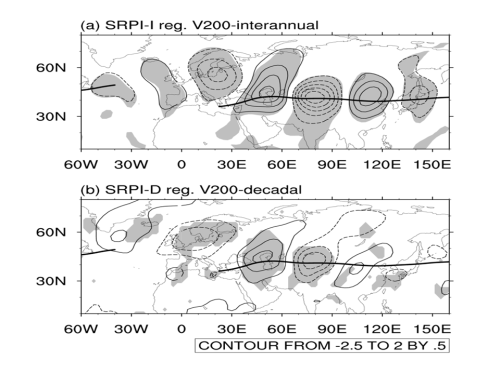The Silk Road Pattern (SRP) in summer is a wave-like teleconnection pattern propagating along the upper-tropospheric Asian westerly jet stream. It manifests as alternate southerly and northerly (or cyclonic and anti-cyclonic circulation) anomalies along the jet, and exerts great influences on climate over the midlatitude Eurasian continent.
Most previous studies about the SRP analyze directly the original data, assuming that the interannual component is the overwhelming majority of the overall SRP. However, some recent studies have shown that this pattern has a considerable decadal variability. It's found the decadal component of the SRP explains about 30% of variance for the overall SRP, and plays a substantial role in the amplified warming over Europe–West Asia and Northeast Asia after the mid-1990s. Therefore, a comparison is of great necessity between the interannual and decadal variability of the SRP.

The 200-hPa meridional wind anomalies (contours; units: m s−1) regressed onto the standardized (a) SRPI-I on the interannual time scale and (b) SRPI-D on the decadal time scale. Contour intervals are 0.5 m s−1 and zero contours are omitted. Solid and dashed contours indicate positive and negative anomalies, respectively. Shading indicates regions of significance at the 0.05 level, and the effective degrees-of-freedom have been considered in (b), according to the Student’s t-test. The bold line delineates the climatological jet axis.
Results of a recently published study in Atmospheric and Oceanic Science Letters by scientists from Institute of Atmospheric Physics, Chinese Academy of Sciences indicate that: The interannual SRP corresponds to a clear wave train across the Eurasian continent, resulting in a similar wave-like pattern of cold and warm surface temperature anomalies. These anomalous circulation and temperature exhibit even better-organized wave-like pattern than those related to the overall SRP, and thus can be explained well by the internal physical mechanisms of the SRP. On the other hand, the circulation anomalies associated with the decadal SRP are similar to those associated with the interannual one from Europe to Central Asia, but are much weaker over East Asia. And there is also a significant temperature anomaly over the Russian Far East corresponding to the decadal SRP, which however, might result from other decadal climate variance rather than the decadal SRP.
Citation: HONG Xiao-Wei, XUE Shu-Hang, LU Ri-Yu, and LIU Yu-Yun, 2018: Comparison between the interannual and decadal components of the Silk Road pattern, Atmospheric and Oceanic Science Letters, 11, doi: 10.1080/16742834.2018.1439661.
Link: https://www.tandfonline.com/doi/full/10.1080/16742834.2018.1439661
